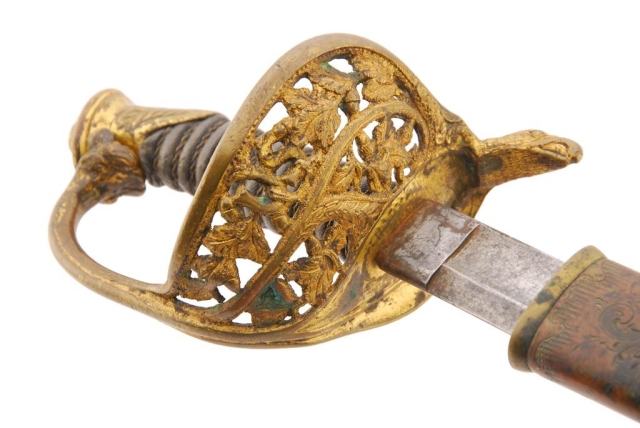 ARIZONA SWORDS
ARIZONA SWORDS 
 ARIZONA SWORDS
ARIZONA SWORDS 
New Item
CLICK BELOW BUTTONS TO SEE AVAILABLE ITEMS
Beware of fake and misrepresented edge weapons.
Click above to see examples of known fakes!
***********************************************************************************************************
CLICK IMAGES TO SEE MORE PHOTOS
***********************************************************************************************************
******************************************************************************************************************************
 Updated 01/08/2026
Updated 01/08/2026
******************************************************************************************************************************
![]()
![]() C650. RARE - CONFEDERATE UNION CAR WORKS
NAVAL CUTLASS: This is an extremely rare Confederate
Union Car Works Naval cutlass. There may be other examples, but I only know of
two complete examples with the original scabbard. This one and one featured in the
book: Collecting the Confederacy by Shannon
Pritchard pages 201-202. He writes “The maker of the cutlass shown
(in the book) is not known with certainty, although some believe it was made by
Union Car Works in Portsmouth, Virginia. It is an incredibly rare Confederate variant.
The distinctive, checkered hand grip is made entirely of wood. The wooden grip
sits inside a copper ferrule. The cutlass is sheathed in its original leather
scabbard with tin toe and leather throat. The blade is nearly perfect.”
C650. RARE - CONFEDERATE UNION CAR WORKS
NAVAL CUTLASS: This is an extremely rare Confederate
Union Car Works Naval cutlass. There may be other examples, but I only know of
two complete examples with the original scabbard. This one and one featured in the
book: Collecting the Confederacy by Shannon
Pritchard pages 201-202. He writes “The maker of the cutlass shown
(in the book) is not known with certainty, although some believe it was made by
Union Car Works in Portsmouth, Virginia. It is an incredibly rare Confederate variant.
The distinctive, checkered hand grip is made entirely of wood. The wooden grip
sits inside a copper ferrule. The cutlass is sheathed in its original leather
scabbard with tin toe and leather throat. The blade is nearly perfect.”
This example is in amazing condition with an original scabbard in better condition than the one featured in the above listed book. There is no movement in the hilt; overall length is 25.5” with a 19” double edged medial ridge blade; 2” wide with cross-hatched wood grip with bulbous top; brass ferrule & cap which tang is peened through. The cross guard is of unusual construction of copper sheathed iron.
The condition is very good to fine++ overall; blade is mottled gray/brown iron patina with fine pitting. Original tool marks appear throughout the length of the blade; grip and cross guard are fine and retains most of its varnish with minor peeling of edges of copper sheathing on guard. Scabbard retains most of its original polish with some cracking and missing frog button.
This is a very scarce pattern and the best one I have everseen especially with original scabbard with the tin drag. Shipping & Insurance is free. $6500.00
******************************************************************************************************************************
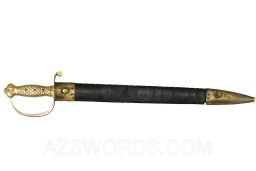 |
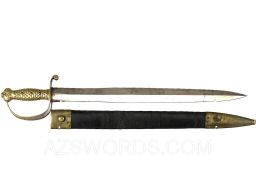 |
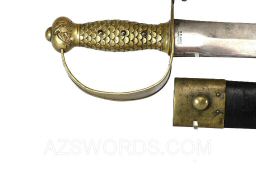 |
 |
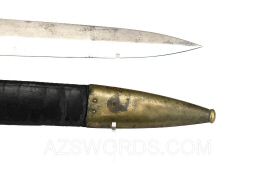 |
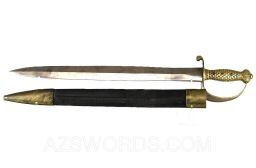 |
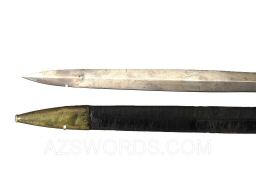 |
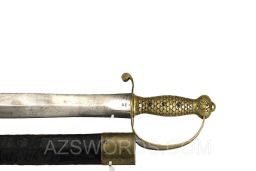 |
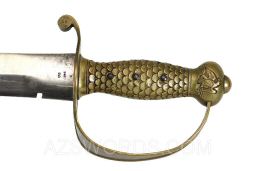 |
 |
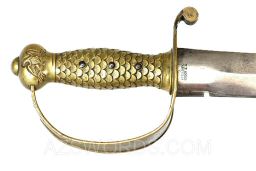 |
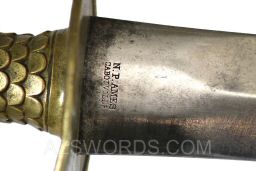 |
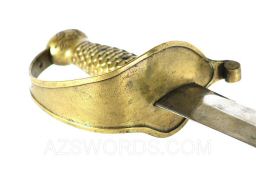 |
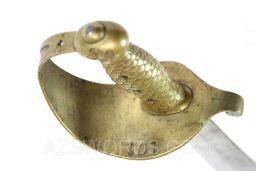 |
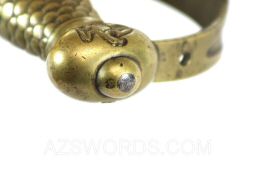 |
A345. AMES MODEL 1841 NAVAL CUTLASS, CABOTVILLE 1846 - ORIGINAL SCABBARD – MEXICAN - AMERICAN WAR & CIVIL WAR: This is an Ames Model 1841 Naval Cutlass with the original leather scabbard. It is Ames maker marked and dated 1846 with US inspection marks. This makes it a 2-war sword with usage in the Mexican – American War & the American Civil War. The hilt is tight and has a soft golden patina, and the unsharpened blade is bright in near mint condition with strong maker and inspection marks. It is inventory number 101 on the inside of the guard. The scabbard is complete, but a little soft with heavy crazing, and weak just above the drag. Both mounts are complete with all rivets. Shipping & Insurance included. $3900.00
******************************************************************************************************************************
 |
 |
 |
 |
 |
 |
 |
 |
 |
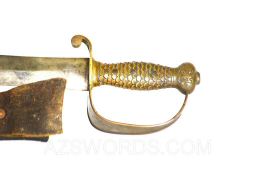 |
 |
 |
A346. AMES MODEL 1841 NAVAL CUTLASS, CABOTVILLE 1846 - 1860 RIVITED SCABBARD - MEXICAN - AMERICAN WAR & CIVIL WAR: As the Civil War approached, the United States Navy realized they had a number of Ames Model 1841 Naval Cutlass in inventory without scabbard and they ordered replacement scabbard from Ames in 1860. These scabbards were different than the original in that they were designed with a leather drag and throat; brass rivets on the front, and a leather frog attached with rivets. The exact number ordered is unknown, but must have been low since they are scarce and rarely seen with the cutlass. It is Ames maker marked and dated 1846 with US inspection marks. This makes it a 2-war sword with usage in the Mexican – American War & the American Civil War. This cutlass is in great condition with a guard in its original shape, and with a nice even dark mustard brown patina. The quillion is inspected “RC.” The period sharpened blade has an even gray patina and is maker marked N. P. Ames Cabotville and inspected US / 1846 / R. The scabbard is solid with no breaks and all rivets, and has the original finish with expected crazing. The blade tip extends out a 1/4 inch at the bottom. It is extremely rare to find this cutlass with this 1860 scabbard. Shipping & Insurance included. $3800.00
******************************************************************************************************************************
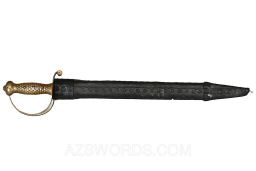 |
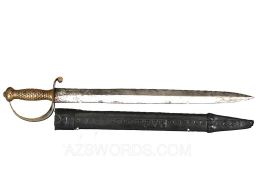 |
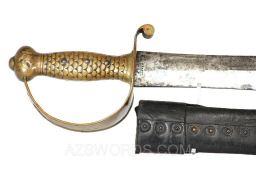 |
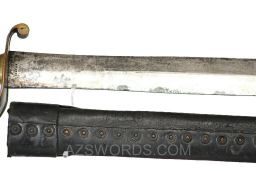 |
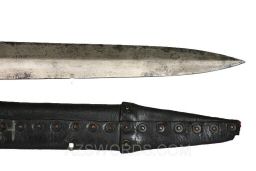 |
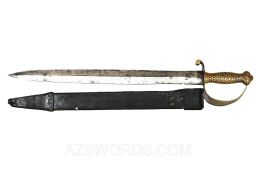 |
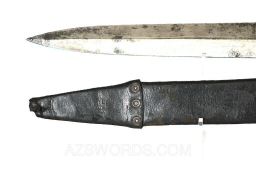 |
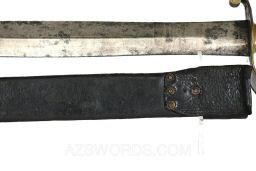 |
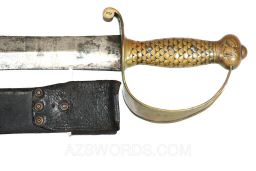 |
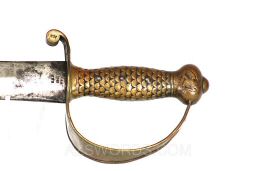 |
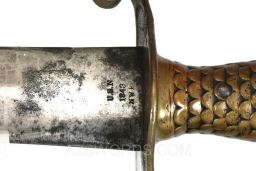 |
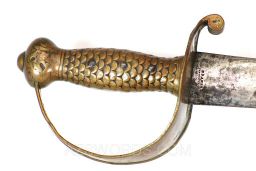 |
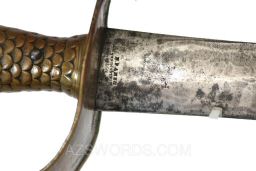 |
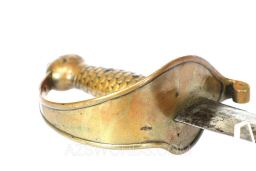 |
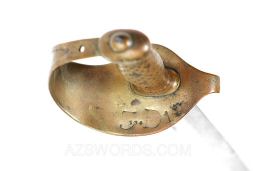 |
A347. AMES MODEL 1841 NAVAL CUTLASS, CABOTVILLE 1843 - 1860 RIVITED SCABBARD - MEXICAN - AMERICAN WAR & CIVIL WAR: As the Civil War approached, the United States Navy realized they had a number of Ames Model 1841 Naval Cutlass in inventory without scabbard and they ordered replacement scabbard from Ames in 1860. These scabbards were different than the original in that they were designed with a leather drag and throat; brass rivets on the front, and a leather frog attached with rivets. The exact number ordered is unknown, but must have been low since they are scarce and rarely seen with the cutlass. It is Ames maker marked and dated 1843 with US inspection marks. This makes it a 2-war sword with usage in the Mexican – American War & the American Civil War. This cutlass is in great condition with a guard in its original shape, and with a nice even dark mustard brown patina. The quillion is inspected “JCB” & “WAT.” The period sharpened blade has an even gray patina and is maker marked N. P. Ames Cabotville and inspected USN / 1843 / NWP with areaof dark spots and pitting. It is inventory number "134" and "3 D 1" on the inside of the guard. The scabbard is solid with no breaks and all rivets,and has the original finish with expected crazing and complete with the attached frog. The blade tip extends out a 1/4 inch at the bottom. It is extremely rare to find this cutlass with this 1860 scabbard. Shipping & Insurance included. $3700.00
******************************************************************************************************************************
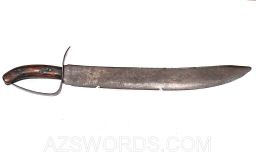 |
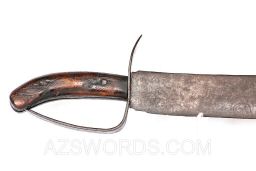 |
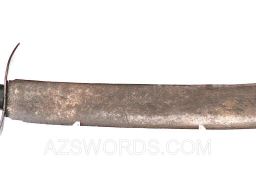 |
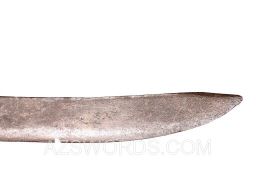 |
|
 |
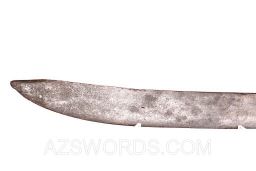 |
 |
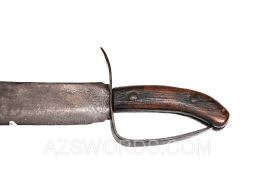 |
 |
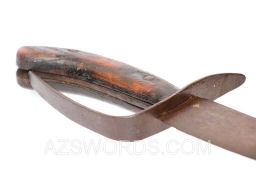 |
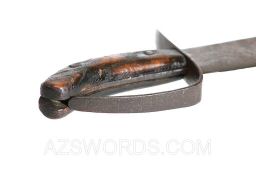 |
 |
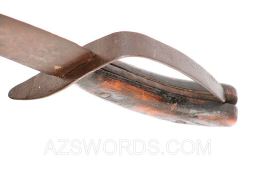 |
C633. CONFEDERATE LARGE TURNED DOWN PLOW SHAPE (PISTOL-GRIP) HANDLED D-GUARD BOWIE: This large Confederate D-GuardBowie has a turned-down plow shape (pistol-grip) handle, with what can be best described as a floating guard. The guard was not peened but held in place by the pressure created by the slabbed wood grips. The walnut grips are held in place with two iron pins, but over time the shrinkage has allowed for some movement. It is 22 3/4” long with a 17 1/4" x 2” wide clip-point blade. The blade and guard have the same deep-brown patina, and the wood has the dark black patina where the iron has leached into the wood. When I saw this knife, I immediately thought of Alabama because of the grip and the heavy blade that is similar to known knives from that state. However, opinions are subjective and this Confederate blacksmith made knife could be from any Southern state. It is unique! Shipping & Insurance is free. $4500.00
******************************************************************************************************************************
 |
 |
 |
 |
 |
 |
 |
 |
 |
 |
 |
 |
C643. CONFEDERATE D-GUARD BOWIE KNIFE TWISTED QUILLION: This is a newly discovered Confederate D-Guard Bowie knife. It is Blacksmith made and unique. It is 18 1/4" long with a 12 1/2" x 2” wide spear-point blade. The blade has great casting flaws and filling marks, and is period sharped on both edges. It is slabbed gripped with both pieces held tight with two iron pins and fitted within the frame of the d-guard. There is a hole on the underside of the guard which most likely is from the metals previous use, and the quillion is twisted pointing forward. The patina on the blade is dark brown and gray-brown on the guard. Also, there is traces of gold paint in the twisted quillion indicating the knife was once a war trophy displayed in a GAR hall. Shipping & Insurance is free. $3500.00
******************************************************************************************************************************
 |
 |
 |
 |
 |
 |
 |
 |
 |
 |
 |
|
 |
 |
 |
 |
 |
 |
******************************************************************************************************************************
C523. CONFEDERATE, GEORGIA – McELROY SHORT ARTILLERY SWORD: This Confederate Short Artillery sword was made by McElroy, Macon Georgia. It has a similar hilt as seen on an E. J. Johnson short artillery sword, but with an oval-shape blade with no fuller. This example is all original with its leather blade washer, which is rare, and has an 18 1/4-inch x 1 3/4-inch blade that was period sharpened and has a few minor nicks. It has a totally untouched patina deep gray patina. The brass hilt is tight with no movements and the tang is peened tight and all original. Great Southern casting flaws in both the brass and blade. One of the better examples without a scabbard! Shipping & Insurance included. $1800.00
******************************************************************************************************************************
 |
 |
 |
 |
 |
 |
 |
 |
 |
 |
F521. COLT 1851 NAVY REVOLVER (.36 CALIBER WITH NAVAL ENGAGEMENT ON CYLINDER, OCTAGONAL BARREL: This is a Colt Model 1851 Navy Revolver with matching serial number 175959: production year 1864. All parts to include the cylinder and wedge have matching numbers. This gun saw use and has an even gray patina. The action is tight and hold both half & full cock positions and properly functions. It has the original grip; screws and nipples but little cylinder scene, and there are two areas on the grip that have lead applied. Shipping & Insurance included. $1995.00
******************************************************************************************************************************
C578. CONFEDERATE – MASSIVE D-GUARD KNIFE: This is a massive Confederate D-Guard knife. It is 20 5/8 inches long with a 15.5 x 2.25-inch clip-point blade and a well-formed large D-guard. The blade is near-bright with areas of dark spot and is period sharpened, and the large guard is tight with no movement. The tool shaped walnut grip is complete with no brake and pinned tight. The knife has not been altered or cleaned, and on the underside of the guard is a museum or collector's inventroy number. If it had the original scabbard this easily would bring $10.000. $4200.00
*****************************************************************************************************************************
C588. CONFEDERATE - LEECH & SHORT ARTILLERY SWORD: This is a Confederate short artillery sword made by Leech & Rigdon. However, this version is void of the C & S cross guard and not known if made in Memphis, Tennessee. It is highly likely it was made either in Alabama or Georgia as they moved production during the war. The hilt is sand cast and has great casting flaws in the guard. The blade is huge at 18 1/4 inches long and 2 1/8” wide with a center fuller, and has great casting flaws, fill marks, and is period sharpened. The leather scabbard is original to the sword and is very solid with the top tin mount, but no drag. When placed side-by-side with the CS cross guard version, you can see the same casting features in the hilt, and the same scabbard throat and leather. This is an extremely rare sword, and every rarer to have the original scabbard. Shipping & Insurance included. $4500.00
******************************************************************************************************************************
 |
 |
 |
 |
 |
 |
 |
 |
 |
 |
 |
 |
C585. CONFEDERATE - VIRGINIA CONTRACT AMES MODEL 1840 NCO SWORD: Prior to the outbreak of the Civil War, the state of Virginia placed an order with Ames in Massachusetts for 1200 cavalry sabers. These sabers were all dated 1860 and Ames maker marked. Some were uninspected, but there are examples that were US inspected. However, for an inspected example to be part of the Virginia contract it must have the secondary Virginia 6-point inspection star. It is also known that Model 1840 Artillery sabers, Model 1840 NCO and Model 1840 Musician swords were also purchased by Virginia. All identified examples of these swords are Ames maker marked; dated 1860; US inspected; and have the Virginia 6-point inspection star, and are extremely rare.
This Ames Model 1840 NCO sword is part of the Virginia Contract with the 1860 date; US inspection; Ames maker mark; and the Virginia6-point inspection star on the underside of the guard. The reverse clam shell was period removed to make it easy to carry. It is tight with a 32 1/4-inch blade, which was period sharpened and has nicks running the entire length of the blade. It has a dark patina which is a good indication it has not had a scabbard since the war. This sword was discovered in Georgia. Shipping & Insurance is included. $1050.00
*****************************************************************************************************************************
 |
 |
 |
 |
 |
 |
 |
 |
 |
 |
 |
 |
CLICK THE ABOVE ICON TO READ THE COMPLETE HISTORY FOLDER
A348: AMES M1832 SHORT ARTILLEY SWORD & SCABBARD 1860 DATED - 1ST VT HEAVY ARTILLEY IDENTIFIED: This Ames Model 1833 Foot Artillery short sword is identified to Private Horace E. Sampson, "D" Co. Vermont 1st Heavy Artillery. However, prior to joining this unit he served in "C" Co. New York 2nd Infantry. Scratched in the swords cross guard is the name H E SAM. A search of the Civil War Data base found only three matches for this name: Horace E. Sampson. One soldier was from Massachusetts and served in the infantry before joining a Heavy Artillery unit, but as a Sergeant and Lieutenant. The second two names are for the same soldier who served in two different units: New York 2nd Infantry & Vermont 1st Heavy Artillery.
With the 2nd Infantry, Horace E. Sampson saw combat Battle of Big Bethel; Battle of Fair Oaks; Seven Days Battles; Battle of Oak Grove; Battle of Glendale; Battle of Malvern Hill; Battle of Bristoe Station; Battle of Groveton; Second Battle of Bull Run; Battle of Chantilly; Battle of Fredericksburg; and was wounded during the Battle of Chancellorsville. He mustered out on 26 May when the New York 2nd Infantry mustered out at the expiration of its term. On 9 November, 1863 Horace E. Sampson enlisted into "D" Co. Vermont 1st Heavy Artillery. What brought him to Vermont was marriage. His widow’s Pension File documents that her husband was from “Troy New York” and “a soldier by occupation,” and he died of Pneumonia on 6 February, 1864.
The sword is an Ames Model 1833 Foot Artillery short sworddated 1860. There were 1000 produced; 500 delivered on February 18, 1860 and 500 delivered on May 3, 1860 making this a Civil War production and very desirable. This hilt has a pleasing patina and the blade is tight with a bright blade with a few minor dark spots. The scabbard is complete with both original mounts and all rivets and has strong leather, which has some crazing. It has matching inspection marks on the drag. Shipping & Insurance is free. $2500.00
******************************************************************************************************************************
 |
 |
 |
||
 |
 |
 |
 |
 |
C632. CONFEDERATE D-GUARD BOWIE KNIFE: This is a very unique looking Confederate D-Guard Bowie knife. It is 18” long with a 13” x 2” inch blade which was period sharpened, and has a totally undisturbed deep-brown patina. The Oak wood grip has a period crack common raw wood being used, but is tightly peened to the large D-Guard, and the quillion is crudely rounded. It is all original and never cleaned. Shipping & Insurance included. $3900.00
******************************************************************************************************************************
C631. CONFEDERATE – MASSIVE D-GUARD BOWIE KNIFE: This is a massive Confederate D-Guard Bowie. It is 24 1/2” long with a 19 1/2” x 2” wide Blacksmith made clip-point blade. The blade has a dark gray patina and has great casting flaws and hammering marks, and is period sharpened. The walnut wood grip is a tool handle with an iron D-Guard both which are tight. It is all original and never cleaned. Shipping & Insurance included. $4300.00 ******************************************************************************************************************************
 |
 |
 |
 |
 |
 |
 |
 |
 |
 |
 |
 |
******************************************************************************************************************************
 |
 |
 |
 |
 |
 |
 |
 |
 |
 |
 |
 |
******************************************************************************************************************************
 |
 |
 |
 |
 |
 |
 |
 |
 |
 |
 |
 |
******************************************************************************************************************************
 |
 |
 |
 |
 |
 |
 |
 |
 |
 |
 |
 |
 |
 |
 |
 |
 |
 |


******************************************************************************************************************************
 |
 |
 |
 |
 |
 |
 |
 |
 |
 |
F481. IMPORTED AUSTRIAN M-1854 LORENZ RILE: This is an Austrian M-1854 Lorenz Rifle Musket, as imported by the Confederacy during the course of the American Civil War. The Lorenz was the third most used infantry arm on both sides during the war, and somewhere between with the US importing approximately 250,000 of the guns during the war and the Confederates importing at least 100,000, and quite possibly more. The Confederacy was always thought to have purchased most of their Lorenz’s after Caleb Huse visited Vienna as the Confederate Ordnance Department purchasing agent 1863, however more recent research indicates that Huse purchased his first Lorenz rifle muskets through S. Isaac, Campbell & Co of London in 1862. It appears that many of the guns that were purchased by the Confederacy were in their original 13.9mm caliber (about .547), while many of the US purchased guns were re-bored to more closely approximate the standard US caliber of .58. The importance of the .54 caliber Austrian M-1854 Lorenz to the Confederacy might best be illustrated by an invoice from the famous English ammunition manufacturer Eley Brothers. The invoice is contained within the McRae Papers, and is dated July 18, 1863 “ some two weeks after the Battle of Gettysburg and the fall of Vicksburg, MS. The invoice is for 700,000 paper cartridges. The order included “600,000 Austrian Rifle Cartridges “ Marked A” and “100,000 Ball & Buck Short Musket Cartridges “ Marked M”. While the caliber of the Austrian cartridges is not specified, it seems clear that the order would be for .54-caliber ammunition, as the order contains no request for any .58 ammunition.
The rifle is in good working order and properly functions and has all original barrel bands and sling swivels. The gun saw heavy action and the rifling is shoot out. The lock is marked 860 for 1860 and the hammer screw has a unique field replacement. The wood is complete with no crakes or breaks with a large cheek rest on one side and carved letters on the other, and the original fixed tombstone rear site. Shipping & Insurance is free. $1750.00
******************************************************************************************************************************
 |
 |
 |
 |
 |
 |
 |
 |
 |
 |
 |
 |
******************************************************************************************************************************
C601. CONFEDERATE – STAR CS SHORT ARTILLERY SWORD: This is a Confederate Star - CS short artillery sword. The hilt displays great cashing flaws and has a dark reddish-brown patina, and the blade has a light-gray patina as a result of being protected by the original scabbard. The flaws on this sword are exactly what you want to find on a Confederate sword, especially the hilt with the casting holes. The scabbard is in amazing condition for being the leather version with brass mounts. It has expected crazing and surface leather loss, but is very solid with no breaks. The brass fittings are original and display casting and filling marks. Shipping & Insurance included. $4600.00
******************************************************************************************************************************
|
|
C411. BOYLE, GAMBLE & MCFEE ARTILLERY SHORT SWORD: This is an artillery short sword made by Boyle, Gamble & McFee of Richmond, Virginia. The sword is in excellent condition with a bright original blade; tight hilt; original scabbard with both copper-brass mounts and fits perfect to the blade. The scabbard is strong though it has some surface leather loss. The blade has period sharpening with a few minor nicks and some areas of dark spots, but no rust or pitting. Shipping & Insurance is included. $3900.00
******************************************************************************************************************************
 |
 |
 |
 |
 |
 |
 |
 |
 |
 |
 |
 |
 |
 |
 |
 |
 |
 |
CLICK THE ABOVE ICON TO READ THE COMPLETE HISTORY FOLDER
C652. 61ST GEORGIA INFANTRY REGIMENT - AMES MODEL 1833 CAVALRY SABER: This Ames Model 1833 Cavalry Saber is identified to Captain James D. Van Valkenburg and most likely was carried by him during the following battles: Seven Days Battles, Gains Mills, Malvern Hill, Bristoe Station, Groveton/Brawner's Farm, Second Bull Run or Manassas, Sharpsburg/Antietam, and Fredericksburg. No doubt this sword became a war trophy when Captain Van Valkenburg was captured during the battle of Fredericksburg and made a Prisoner-of-War.
This is an early example of an Ames Model1833 Dragoon saber and most likely was a factory special order by Van Valkenburg himself. It is well known that the Ames Manufacturing Company provided swords to the South both before and during the Civil War, and to conceal this activity the maker and inspection marks were often removed as is the case in this sword. The hilt is missing all the leather & wire as well as some original wood, which has caused a little movement in the hilt. The sword shows heavy wear with the guard being bent and Ames and inspection marks removed. On the blade is pen-etched Capt. James D Van Valkenburg and 61st Georgia Regiment on opposing sides. It is exceptionally well done and conforms to the etching style unique to Ames for the period and this pattern sword. The scabbard fits perfect to the blade and has a deep brown patina which has never been cleaned and shows exposure and use consistent with the sabers hilt and blade. Additionally, it has the spit rings common to early produced Ames sabers.
There are three tiny pin holes below the middle mounts as well as two small holes between the ring mounts. These holes were enough to allow moister to enter, which no doubt caused some pitting on the blade and lead to the dark gray patina making it difficult to decern the inscription without magnification and lighting. At the same time, the etching is under the pitting validating its authenticity! Included is a 103-page history binder, and shipping and insurance is free. $6500.00
******************************************************************************************************************************
 |
 |
 |
 |
 |
 |
 |
 |
||
 |
 |
 |
 |
 |
C645. CONFEDERATE PURCHASED GEORGIA “G” P-1853 SABER: The Pattern 1853 Cavalry Saber was an iron mounted, straight bladed saber with a spear point, flat back, and a single fuller. The blades were nominally 34” in length, although some minor variations have been noted. The guard was a 3-branch, wrought iron affair, with a forward swept iron quillon topping the guard, and an iron pommel cap. The grips were a pair of laminated, pressed leather “slabs” that were roll-embossed with a checkered pattern and pinned to the tang of the blade, which was secured to the pommel cap by peening. The saber was carried in a simple sheet metal scabbard with a pair of iron suspension rings that allowed it to be attached to the saber belt hangers. It is known that many of these sabers were acquired by the Confederacy through S. Isaac, Campbell & Company, and to date, the one consistent feature found on the iron hilted P-1853 sabers that have Confederate provenance is that the spines are marked, near the hilt, either ISAAC & Co or SIC & Co LONDON. This makes sense as all known invoices for the purchase of English P-1853 cavalry sabers are from S. Isaac, Campbell & Company. What none of the extant documents or invoices reveals is the number of these sabers that were acquired by the State of Georgia. A few examples of the P-1853 saber are known with a capital “G” stamped on the reverse near the ricasso, with the same mark found on the scabbards between the throat and upper mounts. The consensus is that the state of Georgia purchased these sabers on their own, as they did with Enfield pattern rifles and rifle muskets, and the swords were stamped with the “Georgia G” in England as the guns were. However, it is possible that the mark was applied in Georgia, pursuant to a mid-war Georgia State Adjutant General’s order to mark all Georgia arms with a “G” for Georgia. There is no estimate as to the number of sabers that were so marked with a “G,” but they are considered quite scarce and a great addition to any collection of Confederate edged weapons.
This is one of the rare “G” marked saber that recently was discovered. It is in attic condition with a scabbard that has a deep brown patina with heavy stippling. As a result, the “G” between the top ring mount and throat is partially obscure but there! The stippling on the guard and its patina match the scabbard, and the pressed leather grips shows wear but are 100% complete. The blade fits perfect to the scabbard and was well protected. It is ISAAC & Co marked on the spine and has a strongly stamped “G” on the blade and is very bright and complete with an original unsharpened blade. Shipping & Insurance is free. $4600.00
******************************************************************************************************************************
 |
 |
 |
||
 |
 |
 |
 |
|
 |
 |
 |
 |
C651. CONFEDERATE, GEORGIA – McELROY SHORT ARTILLERY SWORD: Gorgeous! Confederate "Gladiator" Style Short Artillery & Wooden Scabbard. This is a Confederate short artillery sword complete with the original wood scabbard made by McElroy, Macon, Georgia. It is a unique variant with the ends of the cross-guard factory ground flat. The hilt has a pleasing dark mustard patina and the blade has a gray-brown speckled patina. The blade is in original factory condition with unsharpened edges and a sharp point, and great casting flaws. The wood scabbard is complete with both tin mounts and the brass fog stud. The sword tip extends out a little at the bottom of the drag. Shipping & Insurance is free. $4200.00
******************************************************************************************************************************
 |
 |
 |
 |
 |
 |
 |
 |
 |
 |
 |
 |
******************************************************************************************************************************
 |
 |
 |
 |
 |
 |
 |
 |
 |
 |
 |
 |
 |
 |
 |
 |
 |
 |
******************************************************************************************************************************
 |
 |
 |
 |
 |
 |
 |
 |
 |
 |
 |
 |
******************************************************************************************************************************
 |
 |
 |
 |
 |
 |
 |
 |
 |
 |
 |
******************************************************************************************************************************
C584. CONFEDERATE CAVALRY OFFICERS SABER: This is a Confederate Cavalry Officers saber with a Thomas Griswold hilt, a Leech & Rigdon scabbard; and a Confederate blade by an unknown maker. It believe it might be a Leech & Rigdon blade produced late in the war. Thomas Griswold was out of New Orleans and Leech & Rigdon was located initially in Memphis. Both locations also had other retailers who sold swords, just like merchants up north, and most likely purchased sword components from both for fabrication. We know Thomas Griswold was forced to close when New Orleans fell, and it is reasonable to assume parts were shipped out prior to the city’s capitulation. With the capture of Forts Henry and Donelson in the spring of 1862 and the subsequent fall of the state of Tennessee into Union hands, Leech and Rigdon decided to relocate their business to Columbus, Mississippi and build a factory adjacent to the Confederate Briarfield Arsenal. Later in 1862, with Sherman making a threat to Mississippi, the Confederate Government decided to relocate the arsenal to Selma, Alabama. Leech and Rigdon relocated with the Arsenal and remained in Selma for a short period. In March of 1863 Leech and Rigdon separated from the arsenal and moved their operations to Goldsboro, Georgia. It is unknown as to everything they made, and this saber is a great example of what happens when resources became scarce and quality suffers. This hilt is clearly Thomas Griswold with its distinct pommel cap and guard with casting flaws, and a grip with 95% original leather and 100% original double twisted brass wire. The Leech & Rigdon scabbard is high quality with brass mounts and drag that have a bead design and all screws. The throat piece has the internal blade retention tabs common to Leech & Rigdon, and the original wood liner is intact. The blade perfectly fits the scabbard; has a fuller designed, but unmarked with large casting flaws at the base. It has a dark brown patina. The blade is tight and there is no movement in the hilt. The blade washer is old leather, but not sure if period. Shipping & Insurance included. $9500.00
*****************************************************************************************************************************
 |
 |
 |
 |
 |
 |
 |
 |
 |
 |
C636. CONFEDERATE D-GUARD BOWIE: This is a Confederate D-Guard Bowie knife in totally original attic condition. It is 19 3/4” long with a 15 5/8 inch by 2 inch wide blade made from a file. If you look at the center of the blade you will see the original file teeth makes on both sides starting at the base. The 4” grip is oak and is tight with no movement and shows rub and dings. On the top are 6 hash marks with the one near the tang being faint from wear. The face of the guard is wide; the D-Guard is narrow for a smaller hand and the tang is untouched. Shipping & Insurance included. $3600.00
******************************************************************************************************************************
 |
 |
 |
 |
 |
 |
 |
 |
 |
 |
 |
 |
 |
 |
 |
CLICK THE ABOVE ICON TO READ THE ARTICLE ON THE CUTLASS
C639. CONFEDERATE NAVAL CUTLASS ATTRIBUTED TO THE CSS FLORIDA: This is a Confederate Naval Cutlass attributed to the CSS Florida. It is 30” long with a 25” heavy “machete” like blade; a cast brass basket guard with 3 branches; a hand fitted sculpted split wood grip secured with 3 iron pins and tightly pinned. The blade has great untouched dark brown patina and is period sharpened. Retired Commander Jerry Roxbury USN wrote a wonderful article for the American Society of Arms Collectors detailing the description and history of this Confederate Naval Cutlass. I have provided a hyper-link to this article and recommend its reading. I will provide a printed copy with the cutlass. Shipping & Insurance is included. $3900.00
******************************************************************************************************************************
 |
 |
 |
 |
 |
 |
 |
 |
 |
 |
 |
 |
Original letter signed by Rafael Eledge
C653. CONFEDERATE – STAR CS SHORT ARTILLERY SWORD: This is a Confederate Star - CS short artillery sword. The hilt displays great casting flaws and has a dark reddish-brown patina, and the blade has a dark-gray even look. This is a totally untouched attic condition sword! The flaws on this sword are exactly what you want to find on a Confederate sword, especially the hilt with the casted CS. This exact sword was retailed by Shiloh Relics earlier this year and came to me as a trade item. Included with the sword is the original 3-page letter signed by Rafael Eledge of which the first page provides the descripiton, click the above image to read it. Shipping & Insurance included. $3650.00
*****************************************************************************************************************************
Remittance by Mail
Send to:
Arizona Swords
530 E. McDowell Road, Suite 107-160
Phoenix, AZ 85004
****************************************************************
Contact Number: (602) 245-4721
© 2004 Arizona Swords azswords.com. All rights reserved in all media.